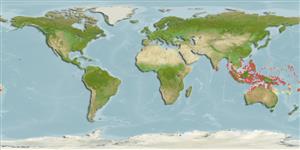Environment: milieu / climate zone / depth range / distribution range
ນິເວດວິທະຍາ
ສັດທະເລ ກ່ຽວກັນຫີນ; ບໍ່ມີການເຄື່ອນຍ້າຍ; ລະດັບຄວາມເລິກ 1 - 12 m (Ref. 90102), usually 2 - 3 m (Ref. 9790). Tropical; 19°N - 23°S
Western Pacific: Philippines, Borneo, Moluccas, Papua New Guinea, New Caledonia, Palau, and Yap Island to Ishigaki Island. Range extended to Mentawai Islands (Indonesia).
ຂະໜາດ / ນ້ຳໜັກ / Age
Maturity: Lm ? range ? - ? cm
Max length : 50.0 cm TL ຕົວຜູ້/ບໍ່ມີເພດ; (Ref. 9710); common length : 35.0 cm TL ຕົວຜູ້/ບໍ່ມີເພດ; (Ref. 9790)
ຄີ (ໜາມ)ແຂງຢູ່ຫຼັງປາ (ທັງໝົດ) : 9 - 10; ຄີຫຼັງຂອງປາ (ຄີອ່ອນ) (ທັງໝົດ) : 11; ຄີ(ໜາມ) ແຂງຢູ່ຄີກົ້ນປາ
ກຸ່ມປາກະດູກແຂງ
ຄວາມຖີ່ຂອງກຸ່ມຖ່າຍທອດພັນ
ປາທີ່ມີການເຄື່ອນຍ້າຍຈາກທະເລໄປຫານ້ຳຈືດ ແລະນ້ຳຈືດຫາທະເລ
ປາທີ່ມີການເຄື່ອນຍ້າຍຈາກທະເລແລະໄປໄຂ່ຢູ່ນ້ຳຈືດ
ຄີກົ້ນຂອງປາ
ສັດທີ່ມີກະດູກສັນຫັຼງ
ການຖ່າຍທອດທາງກຳມະພັນຈາກພໍ່ແມ່ຫາລູກ: 0; ຄີກົ້ນຂອງປາ: 11. Small juveniles all black, gradually changing to the blotched pattern of the adult (Ref. 48635). Rear edge of maxilla ends well in front of eye. Prominent pit present behind upper eye. Preopercular spines short, usually 2, subequal. Infraorbital ridge usually smooth over eye. Suborbital ridge largely smooth, bearing 2 spines below eye. Oblique scale rows slanting backward above lateral line more or less equals number of lateral-line scales. Dermal papillae (10-12 in adults) on upper eye, some simple, some branched, longest not reaching supraorbital ridge. Interopercular flap usually broader than long, with several subdivisions.
Lives on sand or rubble substrates of sheltered or semi-exposed reefs to a depth of at least 8 m (Ref. 9710). Well camouflaged on reefs (Ref. 48635). Also found in coral reefs and mangrove area in about 1-12 m (Ref 90102).
Life cycle and mating behavior
ການຈະເລີນເຕັມໄວ | ການສືບພັນ | ການວາງໄຂ່ | ໄຂ່ | ຄວາມດົກຂອງໄຂ່ປາ | ຕົວອ່ອນ
Myers, R.F., 1991. Micronesian reef fishes. Second Ed. Coral Graphics, Barrigada, Guam. 298 p. (Ref. 1602)
IUCN Red List Status (Ref. 130435: Version 2024-2)
Threat to humans
Harmless
Human uses
ການປະມົງ: ການປະມົງແບບກຸ້ມຕົນເອງ
ເຄື່ອງມື
Special reports
Download XML
ແຫຼ່ງອີນເຕີເນັດ
Estimates based on models
Preferred temperature (Ref.
123201): 27.8 - 29.3, mean 28.8 °C (based on 1532 cells).
Phylogenetic diversity index (Ref.
82804): PD
50 = 0.5625 [Uniqueness, from 0.5 = low to 2.0 = high].
Bayesian length-weight: a=0.00525 (0.00315 - 0.00874), b=3.12 (2.97 - 3.27), in cm total length, based on LWR estimates for this species & (Sub)family-body (Ref.
93245).
ຊັ້ນເຂດຮ້ອນ (Ref.
69278): 4.5 ±0.0 se; based on diet studies.
ຄວາມຢືດຢຸ່ນ (Ref.
120179): ຂະໜາດກາງ, ປະຊາກອນຕຳ່ສຸດທີ່ໃຊ້ເວລາສອງເທົ່າ 1.4 - 4.4 ປີ (Preliminary K or Fecundity.).
Fishing Vulnerability (Ref.
59153): Moderate vulnerability (40 of 100).
Nutrients (Ref.
124155): Calcium = 46.7 [23.0, 116.0] mg/100g; Iron = 0.631 [0.277, 1.412] mg/100g; Protein = 18.1 [15.9, 20.2] %; Omega3 = 0.116 [0.049, 0.325] g/100g; Selenium = 28 [14, 78] μg/100g; VitaminA = 130 [46, 351] μg/100g; Zinc = 0.916 [0.587, 1.443] mg/100g (wet weight);
